Name: Blackhaw
Botanical Name:Viburnum prunifolium
Form: shrub or small tree
Parts Used: berries, browse
Citation: Guenther, K. (2017, January 12) Blackhaw as wildlife food [Web log post.] Retrieved: Reader supplies the date, from http://wildfoods4wildlife.com
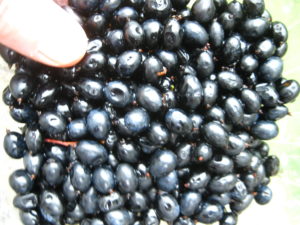
Getting Started
Blackhaw is one of my favorite shrubs to forage. It’s a good bet that all thrushes will like the berries. Blackhaw is scattered throughout the woods of my area, yet was invisible to me for years until I learned to pay attention to their spring bloom when they stand out against the green background. Viburnums as a whole rank #21 on our Favorite Fruits List, and #18 on our Best Browse List. The berries are just beautiful hanging against their rich, fall red foliage. Though this is not the easiest beginner forage plant to find and identify, it is also not hard to find blackhaw by training your eye to look for the spring white blooming shrubs in wild woods and making note of where to come back to for fall fruit. Start looking for the white clusters of blooms from mid-April to mid-May. Take some flagging tape and mark the shrub with some notes to guide you back to the location for fruit in the fall. Since these are an understory shrub, they just seem to blend into the scenery from any distance once they lose their flowers.
Adoxaceae (Viburnum family)
Viburnum (Viburnum genus)
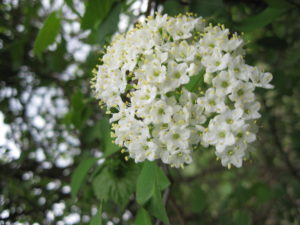
| Common name | Virginia Viburnum Species | Origin | Rare Plant Status |
| maple-leaf viburnum | V. acerifolium | native | not rare |
| northern wild raisin | V. cassinoides | native | not rare |
| arrow-wood | V. dentatum | native | not rare |
| linden arrow-wood | V. dilatatum | non-native | not rare |
| hobblebush | V. lantanoides | native | yes, in some states (not Virginia) |
| nannyberry | V. lentago | native | Globally secure, critically imperiled in Virginia |
| possum-haw | V. nudum | native | yes, in some states (not Virginia) |
| snowball | V. opulus | native and introduced | not rare |
| japanese snowball | V. plicatum | non-native | not rare |
| black haw | V. prunifolium | native | yes, in some states (not Virginia) |
| downy arrow-wood | V. rafinesqueanum | native | yes, in some states (not Virginia) |
| rusty black haw | V. rufidulum | native | not rare |
| tea viburnum | V. setigerum | native | not rare |
| siebold’s viburnum | V. sieboldii | non-native | not rare |

Key Features to Look For
In addition to the identification guide of your choice, here are a couple of features you should see on this shrub:
- Opposite branching
- Black/blue shiny berries in clusters on red stems and clusters hang downward, berries are green on red stems when immature
- Dry berries, not juicy, with a single, large, flat, oval seed
- Arching branches
- Very fine teeth on the leaves
- Multiple trunks
-
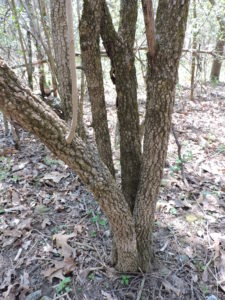
Typical multiple trunks of viburnum shrubs.
About this Species
This fall food is utilized widely across mammals and birds. Due to the berry’s dry nature, it persists on the bush for up to a month or more. Some bushes can be very heavily laden in some years.
Flower Description: Small, 5-petalled white individual flowers with tall yellow anthers, many flowers make up a showy rounded clusters the size of your fist. Blooms mid April to mid-May.
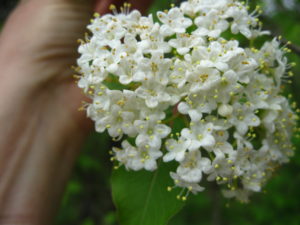
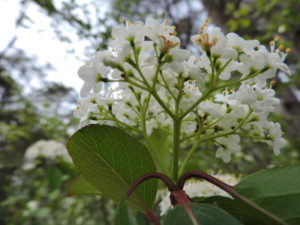
Leaf Description: Opposite leaves, elliptical and very finely toothed. Leaf stems tinged with red.
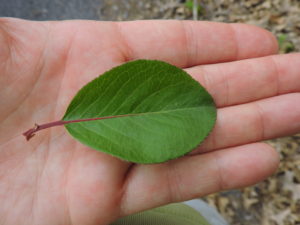
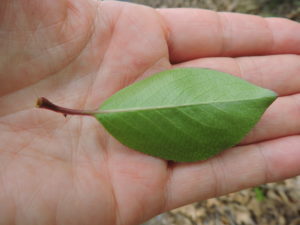
Seed/ Fruit Size: Berry clusters hang downward and have red stems on the berries. The ripe fruit is shiny black when ripe, slightly elliptical with a 3/32 inch (2 mm) petiole (stem) that stays attached to fruit after picking. The berry itself is about 3/8 inch (10 mm) long by ¼ inch (7 mm) wide, but the seed inside is only slightly smaller than the fruit but is very flat—only 3/32 inch (2 mm) thick. So there is not a lot of flesh on this fruit, it is not juicy, even at peak ripeness. Sometimes the berry even starts to dry and shrivel on the bush.
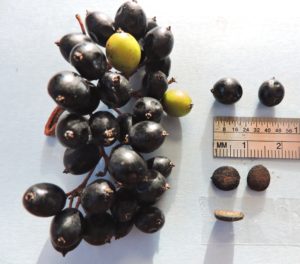
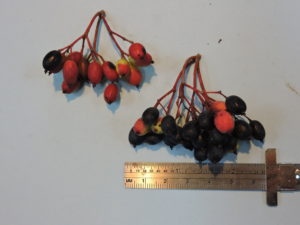
Harvest
| Jan | Feb | Mar | Apr | May | Jun | Jul | Aug | Sep | Oct | Nov | Dec | ||||||||||||||
|---|---|---|---|---|---|---|---|---|---|---|---|---|---|---|---|---|---|---|---|---|---|---|---|---|---|
| winter | winter | late winter | early spring | spring | late spring | early summer | summer | late summer | early fall | fall | late fall | ||||||||||||||
| fruit | x | x | x | x | x | ||||||||||||||||||||
| browse | x | x | x | x | x | x | x | x | x | x | x | ||||||||||||||
Is this a good enrichment item? Not great, really, though maybe you could prune off the ends of branches and wrap in a sheet for transport and install in enclosures being careful not to bump off the berry clusters.
Harvesting Fruit: Berries turn from green to yellow/chartreuse to pinkish before turning deep blue/black. All the berries do not ripen exactly at the same time. Handpick berries only when they are a ripe, deep blue/black.
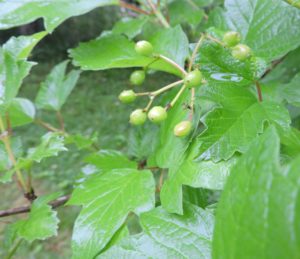
Storing Prepared Fruit
Commercial berry containers are great for storing fruit because the rigid plastic keeps fruit from getting crushed and they also have small holes in them which control the humidity in the container. This slows the fruit from drying out too quickly, but allows air circulation to reduce molding.
Viburnum berries keep well in re-used commercial clamshell berry containers in the refrigerator for one to two weeks. It is ideal to use this fruit fresh, if at all possible.For a fruit, they freeze somewhat well and are not as mushy as most fruits upon thawing due to their lower moisture content. Nutrients will be preserved if frozen.
Spread berries in a single layer on a cookie sheet and place in freezer for 1 day. Once frozen, repackage them into zipping freezer baggies (3 mils or thicker) or glass jars to keep them from drying out, remove as much air as possible from the baggie, label and store in freezer until needed—no more than 1 year. Avoid freezing, thawing and refreezing as might happen in a door of a freezer.
See more detailed instructions under the tab “Food Harvest, Process and Storage.”
Harvesting Browse
Browse as a term used on this website refers to the twigs and small branches, with or without leaves or needles, of trees, shrubs, vines and other woody stemmed plants. Browse can also refer to bark, for the animals that gnaw on bark.
Small trees cannot tolerate very much cutting and survive. The best time to harvest browse for the health of the tree is late fall to winter, but that may not be when you need the browse. The best limbs to remove are ones that rub together and cause abrasions that can make the tree vulnerable to insect damage. Or, cut branches that are overcrowded or hang low to the ground. Prune branches back to the base where the branch meets the trunk to minimize future insect damage to the tree.
Dip pruning shears into a bleach water solution (1:3) to minimize transferring tree diseases from one tree to the next.
Place the cut end of the browse in a bucket of water as soon as possible after cutting- ideally taking a bucket of what with you as you harvest because the branch will start to close itself off the instant it is injured. Then keep them in water as much as possible prior to feeding, which ideally means even during transport.Keep bucket of browse in the shade.
Browse cuttings are best fed to animals right away, they do not store well for more than a day before the leaves start to wilt and dry out, especially if it is hot.
Other Viburnum Species
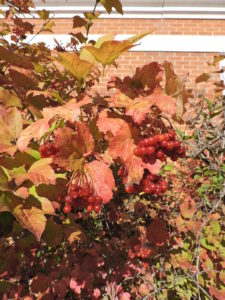
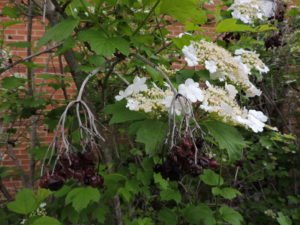
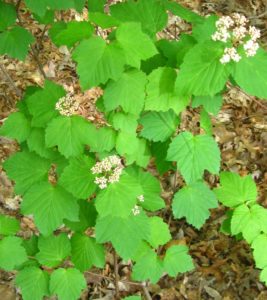
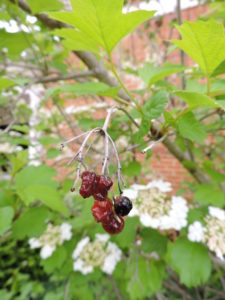
Rare Viburnum Species in Virginia
Do you live in one of these Virginia counties? If so, be aware that there are some species near you that may be threatened or endangered. Do more research to make sure you are identifying your target species correctly and not harvesting a threatened species!
That being said, I think species-level ID is a little bit difficult for viburnums. So I felt validated for the difficulty I was having when I read that nannyberry and rusty blackhaw sometimes hybridize with blackhaw. Since I wouldn’t want to physically damage an imperiled species, I would not harvest browse from blackhaw in the below listed counties, just in case I was off on my species ID and had nannyberry in hand instead.
| County in Virginia | Rare Viburnum Species | Alert |
| Augusta | nannyberry | globally secure, critically imperiled in Virginia |
| Giles | nannyberry | globally secure, critically imperiled in Virginia |
| Highland | nannyberry | globally secure, critically imperiled in Virginia |
| Page | nannyberry | globally secure, critically imperiled in Virginia |
Feed Blackhaw and other Viburnums to:
viburnum | (Viburnum spp.) | browse/bark |
|---|---|---|
Beaver, American | Castor canadensis |
|
Cottontail, Eastern | Sylvilagus floridanus |
|
Deer, White-tailed | Odocoileus virginianus |
|
Elk, Rocky Mountain | Cervus elaphus |
|
Hare, Snowshoe | Lepus americanus |
|
Moose | Alces americanus |
|
Skunk, Striped | Mephitis mephitis |
|
Squirrel, American Red | Tamiasciurus hudsonicus |
|
Squirrel, Eastern Fox | Sciurus niger |
|
Squirrel, Eastern Gray | Sciurus carolinensis |
|
viburnum | (Viburnum spp.) | fruit |
Bear, American Black | Ursus americanus |
|
Chipmunk, Eastern | Tamias striatus |
|
Cottontail, Eastern | Sylvilagus floridanus |
|
Deer, White-tailed | Odocoileus virginianus |
|
Fox, Red | Vulpes vulpes |
|
Mouse, Common White-footed | Peromyscus leucopus |
|
Skunk, Striped | Mephitis mephitis |
|
Squirrel, American Red | Tamiasciurus hudsonicus |
|
Squirrel, Eastern Fox | Sciurus niger |
|
Squirrel, Eastern Gray | Sciurus carolinensis |
|
Bluebird, Eastern | Sialia sialis |
|
Cardinal, Northern | Cardinalis cardinalis |
|
Catbird, Gray | Demetella carolinensis |
|
Finch, Purple | Carpodacus purpureus |
|
Flicker, Northern | Colaptes auratus |
|
Flycatcher, Great-crested | Myiarchus crinitus |
|
Grosbeak, Rose-breasted | Pheucticus ludovicianus |
|
Jay, Blue | Cyanocitta cristata |
|
Mockingbird, Northern | Mimus polyglottos |
|
Phoebe, Eastern | Sayornis phoebe |
|
Robin, American | Turdus migratorius |
|
Sparrow, Song | Melospiza melodia |
|
Sparrow, White-throated | Zonotrichia albicollis |
|
Starling, European | Sturnus vulgaris |
|
Thrasher, Brown | Toxostoma rufum |
|
Thrush, Bicknell's | Catharus bicknelli |
|
Thrush, Gray-cheeked | Catharus minimus |
|
Thrush, Hermit | Catharus guttatus |
|
Thrush, Swainson's | Catharus ustulatus |
|
Thrush, Wood | Hylocichla mustelina |
|
Vireo, Blue-headed | Vireo solitarius |
|
Vireo, Red-eyed | Vireo olivaceus |
|
Vireo, White-eyed | Vireo griseus |
|
Bobwhite, Northern | Colinus virginianus |
|
Grouse, Ruffed | Bonasa umbellus |
|
Grouse, Sharp-tailed | Tympanuchus phasianellus |
|
Pheasant, Ring-necked | Phasianus colchicus |
|
Turkey, Wild | Meleagris gallopavo |
|
Book Resources:
Martin, A.C., Zim, H.S., Nelson, A.L. (1951). American Wildlife and Plants: A Guide to Wildlife Food Habits. New York: Dover Publications.
Scott, M. (2013). Songbird Diet Index. National Wildlife Rehabilitators Association, St. Cloud, MN.
Townsend, J. F. (2015, April) Rare Plants Natural Heritage Technical Report 15-10. (Unpublished Report) Richmond, Virginia: Virginia Department of Conservation and Recreation, Division of Natural Heritage.
On-line Resources:
Coladonato, Milo. 1993. Viburnum acerifolium. In: Fire Effects Information System, [Online].
U.S. Department of Agriculture, Forest Service, Rocky Mountain Research Station, Fire Sciences Laboratory (Producer).
Available: http://www.fs.fed.us/database/feis/ [2016, November 15].
Matthews, Robin F. 1992. Viburnum edule. In: Fire Effects Information System, [Online].
U.S. Department of Agriculture, Forest Service, Rocky Mountain Research Station, Fire Sciences Laboratory (Producer).
Available: http://www.fs.fed.us/database/feis/ [2017, February 2].
USDA, NRCS. 2015. The PLANTS Database (http://plants.usda.gov, 24 November 2015). National Plant Data Team, Greensboro, NC 27401-4901 USA.
Virginia Botanical Associates. (Accessed November 2015). Digital Atlas of the Virginia Flora (http://www.vaplantatlas.org). c/o Virginia Botanical Associates, Blacksburg.
